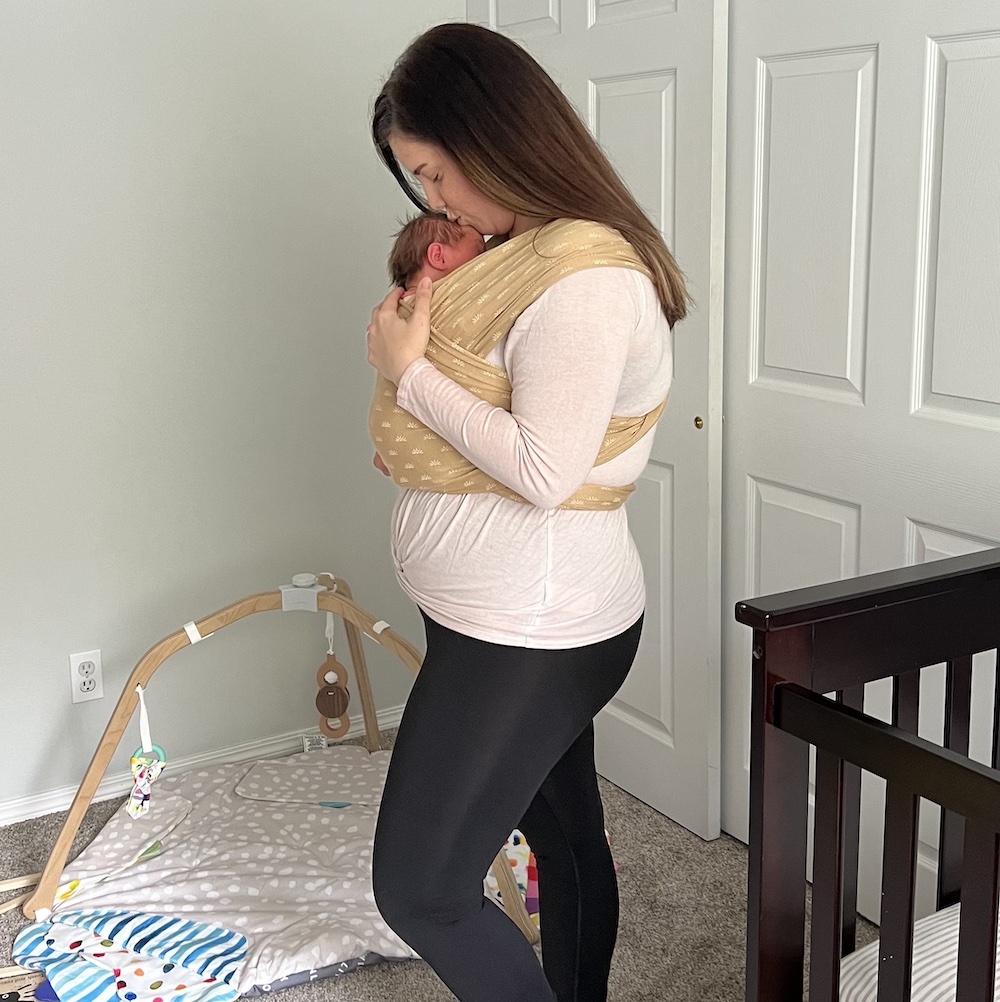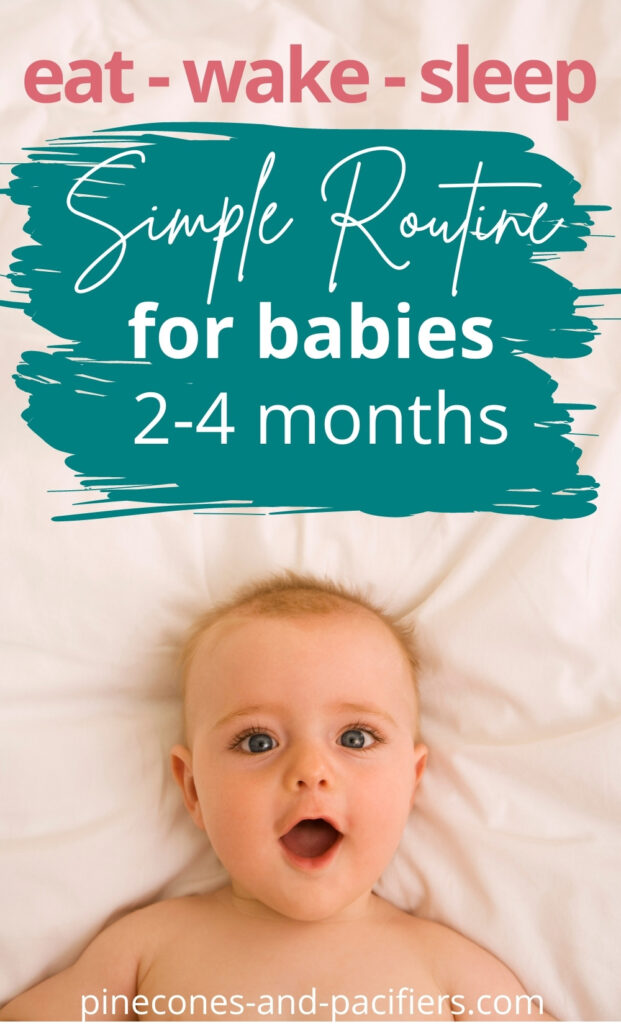Everyone thrives on a routine. Toddlers, kids, adults, and even babies!
With both of my babies we started on a routine right when they came home from the hospital. Sure, it was a very flexible routine at first––the first few weeks are really about survival (see 8 newborn survival tips here!)––but over time it became more and more like a set daily schedule.
With this schedule, both of my babies have only ONE nightly wake up by 2 months old… and “night time” for me is a 12 hour stretch of time!
Below i’m sharing our 2 month old schedule. The foundation of our schedule is based on the book On Becoming Babywise. It goes into a lot more detail than I explain below, so I highly recommend reading the book yourself!
2 Month Old Sleep Essentials
As a mom of three, here are some of my tried-and-true baby sleep essentials.
Hatch Rest+ Baby Sound Machine: White noise can help your baby fall asleep easier and stay asleep longer! This is a white noise machine that also has a night light for those nighttime feeds. This will grow with your baby and can be used as an okay-to-wake clock into the toddler years.
Halo Sleep Sack: a sleep sack can help keep your baby warm and cozy and is safer than loose blankets in the crib. My babies wear these from about 2 months until they move into a bed around 2.5-3 years old.
Solly Baby Crib Sheets: we love these crib sheets because they are super soft and great quality!
To see all of my favorite baby must-haves, check out this related post: Baby Registry Must Haves
Why Have a Baby Schedule?
I choose to set a schedule for my babies for a few different reasons.
First, a schedule can help ensure that you are feeding your baby enough during the daytime. The schedule for a newborn should have feeds no more than 3 hours apart. Both of my babies would have chosen to go longer than this at some times, but that is not good for their growth or for my supply when breast feeding.
If you expect them to sleep longer and eat less frequently at night, then they need to eat enough calories during the day. Scheduling ensures they get enough calories during the daytime hours.
Secondly, a schedule can help regulate their body and let them know what to expect during the day and approximately when they will have their next meal. After a few weeks on this schedule they started napping better and being less cranky overall. Their bodies learned when to expect to eat and when to sleep.
Finally, for the sanity of the family. Our babies are part of our family and not the center of it. Often times we needed to schedule appointments or had other commitments outside of the house. Knowing approximately when my babies would nap each day and when they would need to eat helped tremendously in scheduling outings!
Need easy snack and meal ideas? Get up to $40 off some of our favorites at Daily Harvest
Important Tip: Flexible not Rigid
It’s very important to mention that your 2 month old babywise schedule should be flexible and not strict. I set an approximate schedule each day that served as a guide. However, if my babies were hungry before the ‘set’ eating time, I fed them!
It taught me to recognize signs of hunger and that every cry might not mean my baby was hungry––they might be tired (how long have they been awake?), bored, or just need comforting.
Setting a schedule can be a great way to outline your day, but babies are not machines. You may have to veer from the schedule occasionally (or often).
How Often Do 2 Month Old Babies Sleep?
At 2 months olds most babies can handle being awake for only 60-90 minutes. This can vary based on the time of day (some babies can handle more awake time as the day goes on), your babies age in weeks, and your baby’s temperament.
How Much Nighttime Sleep for a 2 Month Old?
A 2 month old can expect 11-12 hours of nighttime sleep, waking 1-3 times for a feeding.
How To Start Baby on a Schedule?
Step 1 – Set The Desired Wake Time
The most important thing to consider when getting on any schedule is the first feeding of the day or the ‘desired wake time’. Starting the first feeding at the right time means setting the tone for your whole entire day! It also helps your baby’s internal clock learn what time to get up.
It may be extremely hard to get up after little sleep and wake your sleeping baby in the morning, but remember its short term pain for long term gains!
Step 2 – Eat-Wake-Sleep
Once you have your baby up at the desired wake time, you can start the first eat-wake-sleep cycle. The eat-wake-sleep cycle means that the baby eats, then has some awake time, and then sleeps.
This ensures your baby is well-rested before eating and can take a nice full feeding. They wont fall asleep on the breast or bottle and will be full and happy.
By following this routine my babies learned not to associate eating with sleep. They did not need to eat or nurse in order to fall asleep, and they learned to fall asleep on their own by self-soothing.
Step 3 – Wake Times
Once you have the eat-wake-sleep routine nailed down its time to focus on the ‘wake time’ or the amount of time your baby is awake between each nap.
Newborn babies are normally only awake for 45-60 mins before they need to nap again. Any longer than this and they are likely overtired. Most babies stretch their wake times by a few minutes each week and can eventually go longer and longer stretches.
When your baby is about 2 months old they may be able to handle 60-90 minutes of wake time.
My 2 month old can currently go about 75 minutes before he shows sleepy cues and needs a nap.By 4 months old he will likely be able to stay awake for about 2 hrs at a time (see our 4 month schedule here).
Step 4 – Nap time
After your baby has been awake for about 60-90 mins (or whatever is appropriate for their age) and is showing sleepy cues, the next step is to lay them down for a nap.
If you are just starting out, try rocking your baby until he is drowsy but not fully asleep. As they get better and better at putting themselves to sleep you can decrease the rocking time so they are less and less drowsy.
Once they wake up from their nap, repeat the eat-wake-sleep cycle again. They should be napping for about 1-2 hours.
If my 2 month old wakes early from his nap I like to give him about 10 minutes of fussing to see if he will re-settle and he often does! If not I will hold him or wrap him in our Solly Wrap for the rest of his nap as long as he is not showing any hunger cues.

Shop the Rising Sun Solly Wrap (pictured above)
Step 5 – Bedtime Routine
After you have repeated the eat-wake-sleep cycle throughout the day, it will eventually be time for bedtime.
For us, bedtime has always been about 11-12 hours before our desired wake time. By about 3-4 months your baby will need 11-12 hours of sleep per night.
Having a bedtime routine signals to your baby that its time to settle down for the night. The bedtime routine should be fairly short and sweet (15-30 mins) and can include things like a bath, reading books, lotion, and getting in their pajamas.
We do a bath most nights and so our bedtime routine looks like this:
- 7:00 pm – take a bath
- 7:15 pm – lotion and pjs
- 7:20 pm – read two books
- 7:30 pm – last bottle of the night
- 7:45 pm – sound machine on, swaddled, and down to bed
It’s very important to have something breaking up the last feed of the night and sleep (don’t feed to sleep). After the last bottle I will burp my baby, turn on his sound machine, swaddle him, and rock him until he is drowsy… but not asleep!
Once our baby is a little older (closer to 4 months) we move the bottle before the bath and set him down to sleep wide awake.
Laying down your baby awake for bedtime sleep (and naps as well) helps him learn how to put himself to sleep and self-soothe and is very important in helping your baby sleep through the night.
For more info check out my post on the importance of a bedtime routine!
Sample 2 Month Old Schedule
Below is the flexible schedule we have been following for our 2 month old.
This schedule has 6 scheduled feedings (one more overnight) and 4 naps.
- 7:30am – wake and feed ?
- 8:45 am – nap 1 ?
- 10:30 am – feed ?
- 11:45 am – nap 2 ?
- 1:30 pm – feed ?
- 2:45 pm – nap 3 ?
- 4:30 pm – feed ?
- 5:45 pm – catnap ?
- 6:30 pm – feed ?
- 7:00 pm – bedtime routine
- 7:30 pm – top off feed ?
- 7:45 pm – down for bed ?
- * 3:00 am – feed?
*Right now my 2 month old is only waking up once per night around 3:00am for a feeding. This is not scheduled, but is approximately when has been waking. He should start extending this (to 4am, 5am, etc) as the weeks go on.
You can definitely adapt the schedule to fit well for your family.
For example, I have him waking up at 7:30 am so that his second nap aligns with my toddler’s at 12:00 pm. This also works well because we normally eat dinner around 5:15/30. Right after dinner I lay my 2 month old down for his last catnap before bed and spend some quality time with my toddler.
If you want to plan ahead or are looking for schedules for older babies check out other posts from my baby schedule series:
- 4 Month Old Baby Schedule
- 6 Month Old Baby Schedule
- 10 Month Old Baby Schedule
- 1 Year old Schedule with 2 naps
- Ultimate 1 Nap Schedule
- Schedule for Newborn & Toddler
Summary of Starting a Schedule
I wanted to summarize the 5 steps I took to get my two month old on a schedule one last time for you!
- Set the desired wake time
- Focus on the eat-wake-sleep routine
- Remember appropriate wake time
- Lay down drowsy for naps
- Set a bedtime routine
For a more detailed explanation on parent-directed feeding check out the book On Becoming Babywise!
Thanks for stopping by!

